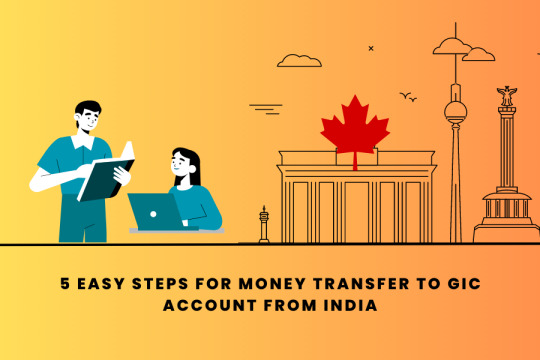#International Money Transfers from India
Explore tagged Tumblr posts
Text

Easy Guide to International Money Transfers from India| Sending Funds Abroad Money transfer refers to the mechanism of proceeding a certain amount of money from one party to another through the financial system. An international money transfer is a process of sending money abroad. International money transfers arise on the account of education, medical treatment, maintenance of family member, shopping, gifts, donations, remittance, salary transfer etc.
For more details about transfer money abroad you can Visit: https://shorturl.at/cyGH5
#Money transfer internationally#Send Money Overseas#International Money Transfers#International Money Transfers from India#International Payment#Send Money Abroad#Sending Money From India#International Fund Transfer
1 note
·
View note
Text
Need to send money abroad? Experience hassle-free online money transfers from Switzerland with RAA Money. Enjoy competitive exchange rates, low fees, and secure transactions, ensuring your funds reach their destination quickly. Whether supporting family, covering education costs, or handling business payments, RAA Money provides a seamless transfer experience. With real-time tracking and 24/7 customer support, transferring money internationally has never been easier. Send funds safely and efficiently today with RAA Money!
#online money transfers from Switzerland#transfer money online#best website for money transfer#international money transfer website#transfer money#send money to india#online services#money#send money to sri lanka#international money transfer
0 notes
Text

It has never been easier to send money abroad from India. Whether you're supporting family, paying for education, or making foreign business payments, there are several secure ways to send money abroad. With developments in banking technology, international money transfers from India are now quick, dependable, and inexpensive. You can choose from a variety of options, including bank transfers, online remittance services, and mobile apps, all of which are designed to be convenient and flexible.
0 notes
Text

Experience unparalleled speed with Unipay Forex, delivering lightning-fast transactions for your global currency needs. Enjoy secure, efficient, and seamless financial exchanges, making your international trading and payments smoother and more reliable than ever before. To know more in details, visit our website today: https://unipayforex.com
#wire transfer#international wire transfer#wire transfer from usa to india#wire transfer from india#wire transfer from india to usa#wire transfer companies#wire transfer from india to canada#wire transfer money
0 notes
Text
Transfer Money Abroad and Make Your Loved Ones Smile
Transfer Money Abroad is a much easier process than you think! You can send money by visiting a bank branch, where you can fill up an A2 form to remit abroad. Alternatively, you can transfer money online in just a few clicks by making online transfers through a bank’s portal. You can also send money from India via remittance service providers and money exchangers.With these multiple options available, it is simple and convenient to remit money from India.An international money transfer can be done safely and conveniently through a bank’s online/offline remittance services through NEFT, RTGS, IMPS or UPI payment mode.Technological progress and increasing connectivity has made it both efficient and affordable to do so, with minimal effort on your part.
#Transfer Money Abroad#Abroad Money Transfer#How to Pay Tuition Fees Abroad from India#International Bank Transfer from India#International Money Transfer from India#International Money Transfer India#International Money Transfer Online#Money Transfer from India#Send Money Abroad#Send Money Abroad from India#Send Money from India#Send Money Overseas#Sending Money Abroad#Transfer Money to Abroad
0 notes
Text
RemitAnalyst: Secure and Affordable Money Transfers from USA to INDIA
Are you searching for the most efficient and cost-effective way to send money from the USA to INDIA? Look no further! RemitAnalyst is your trusted partner for secure and affordable international money transfers. Whether you're sending money to family, covering expenses, or investing in opportunities across borders, we've got you covered.
Why Choose RemitAnalyst for Sending Money to INDIA?
Competitive Exchange Rates: At RemitAnalyst, we understand the significance of getting the best value for your money. Our platform offers highly competitive exchange rates for converting USD to INR. Say goodbye to hidden fees and unfavorable rates.
Secure and Reliable: Your peace of mind is our priority. We employ state-of-the-art security measures to ensure that your transactions are safe and reliable. You can trust RemitAnalyst for all your international money transfer needs.
User-Friendly Interface: Our user-friendly platform makes sending money to INDIA a breeze. With just a few clicks, you can initiate your transfer and track it in real-time. No more endless paperwork or confusing processes.
24/7 Customer Support: Have questions or need assistance? Our dedicated customer support team is available around the clock to assist you. We're here to make your money transfer experience seamless and stress-free.
How to Get the Best Exchange Rate for Your USD to INR Transfer
Getting the best exchange rate is crucial when sending money internationally. Here are some tips to maximize your savings with RemitAnalyst:
Monitor Exchange Rates: Keep an eye on the USD to INR exchange rates using our platform. Exchange rates can fluctuate, so timing your transfer strategically can lead to better rates.
Flexible Transfer Options: RemitAnalyst offers various transfer options, including spot contracts and forward contracts. Discuss your needs with our team to choose the best option for your specific situation.
Leverage Currency Alerts: Set up currency alerts to receive notifications when the exchange rate hits your desired target. This way, you can make your transfer at the most opportune moment.
Consider Batch Transfers: If you have recurring transfers or plan to send money regularly, inquire about batch transfers. This can streamline the process and potentially reduce costs.
Don't let high fees and unfavorable exchange rates eat into your hard-earned money. Trust RemitAnalyst for your USD to INR money transfers and experience a seamless, cost-effective, and secure way to send funds to INDIA from the USA.

Join thousands of satisfied customers who have made RemitAnalyst their go-to platform for international money transfers. Start your transfer today and enjoy the benefits of our competitive exchange rates and exceptional service.
Sending money to INDIA has never been this easy. Choose RemitAnalyst and transfer with confidence. Your money, your way.
#Send money to INDIA#USD to INR transfer#Best exchange rates for USD to INR#International money transfers#Money transfer from USA to INDIA#Secure money transfer services#Competitive currency exchange rates#RemitAnalyst money transfer#Reliable money transfer options#Safe and affordable USD to INR transfers#Real-time exchange rate monitoring#Currency transfer solutions#Hassle-free international money transfers
0 notes
Text
5 Easy Steps for Money Transfer to GIC Account from India

For individuals looking to study, work, or settle in Canada, a GIC (Guaranteed Investment Certificate) account is a crucial financial requirement. It demonstrates that you have sufficient funds to cover your expenses while residing in Canada. Transferring money to a GIC account from India is a straightforward process that involves a few essential steps.
Read More: https://orientremitbangalore.blogspot.com/2023/07/5-easy-steps-for-money-transfer-to-gic.html
#send money abroad#gic account opening#send money overseas#international money transfer#money transfer from india to canada
0 notes
Text
International money transfer India
At Remit out , we provide reliable and hassle-free international money transfer services to India. Whether you need to send money for personal reasons, business transactions, or support your loved ones, our platform offers a secure and efficient solution to meet your needs.
With India being a hub of global commerce and a vibrant economy, our services cater to individuals, businesses, and organizations around the world. Our goal is to make the process of transferring money to India seamless and cost-effective, ensuring your funds reach their destination quickly and securely.
As a trusted financial institution, we leverage cutting-edge technology and a vast network of banking partners to offer competitive exchange rates and low fees for your international transfers. Our streamlined online platform allows you to initiate transfers from the comfort of your home or office, eliminating the need for time-consuming visits to physical locations.
0 notes
Text

Zenith Forex offers Inward and Outward Remittance from India to abroad including Wire Transfer & TT, International Money Transfer or Foreign Exchange.
#outward Remittance#send money abroad from India#Inward and outward Remittance#transfer money abroad#money remittance#International Money Transfer
0 notes
Text
🌸 Paid Readings by Tabitha 🌸
Welcome! 🌿 I’m Tabitha, and I’ve been offering spiritual guidance and tarot readings for 4 years. I’m experienced in tarot, lenormand, wild unknown archetypes and I also use oracle cards.
I’m all about connecting with you on a personal level, making sure every reading feels like we’re just having a friendly discussion. Whether you want to explore love, career, past lives, or anything else that’s on your mind, I’ll give you a reading that’s personalized just for you.
Each reading I offer is carefully tailored to your unique energy and situation. My style is relaxed, honest, and down to earth. I believe in offering readings that are supportive, insightful, and empowering, without any unnecessary fluff 🌸
Your contribution helps me continue this spiritual practice while also helping you navigate through life with a bit more clarity 💗
🧿General Information:
💌 Readings available via: email or Tumblr DM
🕒 Turnaround time: 1-3 days after payment
💲 Pricing:
• International: 5-6 USD per reading
• Indonesia: 20.000-35.000 IDR per reading
• India: 150-222 INR per reading
Message me on Tumblr or email me at: [email protected] to book a reading 💕
🌷 Readings Offered 🌷
🧿 Who Is Your Future Lover/Spouse? (6$/IDR 35.000/INR 222)
How’s their personality, traits, and possible life story of your future lover/spouse
Where and when will you meet them
Their possible physical traits
🌟 Any Topic Reading (except death or health) (5$/IDR 20.000/INR 150)
Ask about love, career, personal growth, or anything else on your mind
I’ll give practical insights and clarity on your most pressing questions.
I’ll give advice based on your current energy
🌸 Past Life Reading (6$/IDR 35.000/INR 222)
Discover the era, location, and significant events from one of your past lives
Find out who you were and explore karmic patterns
Learn how your past life impacts your present.
🌿 What is your destined careeer? (5$/IDR 20.000/INR 150)
Explore the career path most aligned with your soul’s purpose
Find out your strengths and discover where you can thrive
Advice on how to take steps toward your ideal career.
🌻 What will my future self tell me? (5$/IDR 20.000/INR 150)
I’ll be a medium for your future self to give you messages , guiding you on your upcoming journey
Gain practical advice on aligning with your future path
Learn how to navigate challenges and make best choices for your future
🍂 What will happen in the next 3 months? (5$/IDR 20.000/INR 150)
Get a sneak peek at what’s coming up in the next 3 months.
Focus on love, career, personal growth, and challenges
Practical advice on how to prepare for what’s ahead.
💫 How will next year be for you? (6$/IDR 35.000/INR 222)
This reading focuses on what the upcoming year has in store for you, giving you a heads up on key themes, opportunities, and challenges you might face. We’ll break down the year into different areas of your life, like career, love, personal growth, and health (but no medical predictions). It’s like getting a sneak peek into the energy and vibes that will be shaping your journey.
I’ll look into:
• Overall theme for your year (What’s the general vibe?)
• Career and money (What can you expect in your work and financial life?)
• Love and relationships (What’s happening in your love life or friendships?)
• Personal growth and spirituality (What areas of your life will need your focus for growth?)
• Challenges you might face and how to navigate them
• Advice on how to make the most out of your year and stay balanced
This is a great reading to help you start the year feeling prepared and ready for whatever comes your way. 💫
💖 Payment Methods 💖
• International: PayPal (DM me for details) and Ko-Fi
• Indonesia: Bank transfer, Gopay, OVO etc
• India: UPI or bank transfer
To book a reading, message me on Tumblr or email me at: [email protected] 💌
✨ A Few Things to Keep in Mind ✨
1. Confidentiality: All readings are completely private.
2. Timing: Readings are based on current energy, and situations can change over time.
3. Feedback: I always appreciate feedback! It helps me grow and gives me insight into how my readings resonate with you.
Thank you for your support and trust! ✨💕 Looking forward to helping you on your spiritual journey🌷🦋

#paid tarot readings#free tarot readings#tarot reading#tarot by tabitha#tarot pac#past life readings#intuitive readings#tarot reading india#tarot indonesia#tarot community#pick a card
12 notes
·
View notes
Text
Good Deficit, Bad deficit 🧐
While a current account surplus or deficit might seem positive or negative at first glance, the reality is more nuanced. The quality of the imbalance matters more.
A deficit funded by productive investments creates future benefits, while a surplus built on unused savings due to a lack of investment opportunities is a missed chance for growth. For example, India's deficit due to gold imports isn't helpful, and a surplus solely from remittances wouldn't be ideal either.
Looking at successful emerging economies, many with persistent deficits, we see a focus on exports. Oil-rich nations like Russia and Iran have surpluses, while export powerhouses like China and Korea are in a similar boat. Rising stars like Vietnam are also export-oriented. This suggests that building long-term export potential is crucial for India's economic health.
In the short term, India can manage moderate deficits by attracting foreign capital through a business-friendly environment.
Here's some positive news: India's service exports, particularly software, travel, and business services, are growing. Remittances from overseas Indians are also on the rise. This, combined with a surplus of $30.8 billion in the last quarter, paints a promising picture.
The takeaway? Don't get hung up on a surplus or deficit label. Focus on building a strong, export-oriented economy that can attract foreign investment when needed.
References:
1. Remittances are money transfers that migrants send to their families and friends in their home countries. They are an important source of income and foreign exchange for many developing countries, especially those in South Asia.
Remittances can help reduce poverty, improve living standards, support education and health care, and stimulate economic activity.
2. Balance of payments: The balance of payments Statistics in India is a systematic record of India's international economic transactions of residents with the rest of the world on account of merchandise, services, unrequited transfers and transfers of capital.
3. Various print and digital outlets and government websites.
2 notes
·
View notes
Text
RAA Money provides fast and secure money transfer services from Switzerland, making it easy to send funds internationally. With competitive rates and reliable transactions, RAA Money ensures your money reaches its destination quickly and safely, helping you manage your global financial needs with confidence.
#online services#international money transfer website#send money to india#best website for money transfer#send money to sri lanka#send money from Switzerland
0 notes
Text
Send Money Abroad from India | International Money Transfer
It has never been easier to send money abroad from India. Whether you're supporting family, paying for education, or making foreign business payments, there are several secure ways to send money abroad. With developments in banking technology, international money transfers from India are now quick, dependable, and inexpensive. You can choose from a variety of options, including bank transfers, online remittance services, and mobile apps, all of which are designed to be convenient and flexible.
0 notes
Text
Mastering the Art of Negotiating Fees for Wire Transfers
In today's globalized world, wire transfers have become an indispensable tool for conducting international transactions. Whether you're sending money to family overseas, paying suppliers for goods and services, or managing finances while studying abroad, understanding how to negotiate fees for wire transfers can save you both time and money. In this blog post, we'll explore strategies for mastering the art of negotiating fees for wire transfers, empowering you to make informed decisions and optimize your financial transactions.

Understand the Fee Structure: Before entering into negotiations, it's crucial to have a clear understanding of the fee structure associated with wire transfers. Fees can vary widely depending on factors such as the sending and receiving countries, the amount of money being transferred, and the financial institution facilitating the transfer. Familiarize yourself with the different types of fees involved, including transaction fees, exchange rate margins, and intermediary bank charges.
Shop Around: Don't settle for the first wire transfer service you come across. Take the time to shop around and compare the fees and exchange rates offered by different financial institutions and money transfer providers. Look for transparent pricing and competitive rates that minimize hidden costs and maximize the value of your transfer. Online comparison tools can be valuable resources for evaluating your options and identifying the most cost-effective solution.
Negotiate with Your Bank: If you have a longstanding relationship with your bank, don't hesitate to leverage it to negotiate lower fees for wire transfers. Schedule a meeting with a representative from your bank to discuss your needs and explore opportunities for fee reductions or waivers. Highlight your loyalty as a customer and inquire about any special promotions or discounts available for international transactions. Negotiating directly with your bank can result in significant savings over time.
Consider Alternative Providers: In addition to traditional banks, consider exploring alternative providers for wire transfer services, such as online money transfer platforms and fintech companies. These providers often offer competitive exchange rates and lower fees compared to banks, making them attractive options for cost-conscious consumers. However, be sure to research the reputation and reliability of any alternative providers before entrusting them with your money.
Bundle Services: Some financial institutions offer discounts or incentives for customers who bundle multiple services, such as checking accounts, savings accounts, and credit cards. Inquire about the possibility of bundling your wire transfer services with other banking products to qualify for reduced fees or special offers. Consolidating your financial relationships with a single provider can simplify your banking experience and potentially lower your overall costs.
Optimize Transfer Timing: The timing of your wire transfer can impact the fees you incur, particularly when it comes to exchange rate fluctuations. Monitor currency exchange rates and choose opportune moments to initiate your transfers when rates are favorable. Additionally, consider scheduling your transfers during off-peak hours to avoid premium pricing associated with high-demand periods. By strategically timing your transfers, you can minimize costs and maximize the value of your transactions.
Explore Fee-Free Options: Some financial institutions offer fee-free wire transfer options for certain types of transactions or under specific conditions. For example, you may qualify for fee waivers if you maintain a minimum balance in your account or if you use a designated transfer method. Review the terms and conditions of your banking relationship to identify any fee-free options that may be available to you. Taking advantage of fee-free alternatives can result in significant savings over time.
Negotiate Bulk Discounts: If you frequently conduct large-volume wire transfers, consider negotiating bulk discounts with your bank or money transfer provider. Demonstrate your commitment to ongoing business and inquire about the possibility of securing preferential pricing based on your transaction volume. Negotiating bulk discounts can yield substantial savings and improve the cost-effectiveness of your international financial transactions.
Stay Informed: The landscape of international banking and wire transfer services is constantly evolving, with new providers entering the market and regulatory changes impacting fee structures. Stay informed about industry developments, regulatory updates, and emerging trends to ensure that you're always equipped with the knowledge needed to negotiate effectively. Subscribe to newsletters, follow industry publications, and engage with financial experts to stay abreast of the latest developments in the field.
Seek Professional Advice: If navigating the complexities of wire transfer fees feels overwhelming, don't hesitate to seek professional advice from a financial advisor or consultant. An experienced professional can offer personalized guidance tailored to your specific needs and circumstances, helping you navigate the negotiation process with confidence and clarity. By tapping into expert knowledge and insights, you can optimize your wire transfer strategies and achieve your financial goals more efficiently.
In conclusion, negotiating fees for wire transfers through Unipay Forex requires a combination of knowledge, strategy, and persistence. By understanding the fee structure, shopping around for competitive rates, leveraging relationships with financial institutions, and exploring alternative providers, customers can maximize the value of their international transactions and minimize unnecessary costs. Whether sending money abroad for personal or business reasons, mastering the art of negotiating wire transfer fees with Unipay Forex empowers individuals to make informed decisions and achieve optimal outcomes in their financial dealings.
#wire transfer#international wire transfer#wire transfer from usa to india#wire transfer from india#wire transfer from india to usa#wire transfer companies#wire transfer from india to canada#wire transfer money
0 notes
Text
How to pay tuition fees abroad from india without breaking the bank?
How to Pay Tuition Fees Abroad from India? Users can send money abroad in 3 simple steps on DCB Remit: 1. Register online on www.dcbremit.com website 2. Register your beneficiary 3. Book a transaction and transfer money to DCB Bank pool account 4. Sit back and relax, as the money will reach your beneficiary within 48hrs! * Digital Money Transfer Services roviders offer exclusive exchange rates with seamless digital journey. Quick and paperless money transfer services.
#How to Pay Tuition Fees Abroad from India#Abroad Money Transfer#International Bank Transfer from India#International Money Transfer from India#International Money Transfer India#International Money Transfer Online#Money Transfer from India#Send Money Abroad#Send Money Abroad from India#Send Money from India#Send Money Overseas#Sending Money Abroad#Transfer Money Abroad#Transfer Money to Abroad
0 notes
Text
Get the Best GBP to INR Exchange Rate to Send Money to India from the United Kingdom
Introduction: Are you looking to send money to India from the United Kingdom? RemitAnalyst offers the best current exchange rates for transferring GBP to INR. With our reliable and secure platform, you can make hassle-free international money transfers, ensuring your funds reach India swiftly and economically. Read on to discover how RemitAnalyst provides the optimal solution for sending money to India.
Secure and Reliable Money Transfers: At RemitAnalyst, we prioritize the safety and security of your funds. Our platform utilizes advanced encryption and secure payment gateways, ensuring your money reaches its destination without any concerns about data breaches or financial losses.
Competitive GBP to INR Exchange Rates: We understand the importance of getting the best value for your money. With RemitAnalyst, you can take advantage of the most competitive GBP to INR exchange rates in the market. This means more money in the hands of your loved ones in India.
Fast and Efficient Transfers: Time is of the essence when it comes to international money transfers. RemitAnalyst ensures swift and efficient transactions, enabling your funds to reach India promptly. Say goodbye to long waiting periods and unnecessary delays.
Transparent and Low Fees: We believe in transparency and strive to keep our fees minimal. With RemitAnalyst, you'll enjoy transparent and low-cost transactions, maximizing the amount your recipient receives in India.
Easy-to-Use Platform: Our user-friendly platform makes sending money to India a breeze. With just a few simple steps, you can initiate your transfer and track its progress in real-time, providing peace of mind throughout the process.
Expert Customer Support: At RemitAnalyst, we take pride in our exceptional customer support team. Should you have any queries or require assistance, our experts are readily available to guide you through every step, ensuring a smooth experience.

Conclusion: For the best GBP to INR exchange rate and seamless money transfers to India from the United Kingdom, trust RemitAnalyst. With our secure, reliable, and efficient platform, you can send money to your loved ones with confidence. Experience the ease of international money transfers with RemitAnalyst and provide a brighter financial future for your beneficiaries in India. Start transferring money today!
#GBP to INR exchange rate#Send money to India from UK#Best money transfer rates#International money transfers
0 notes